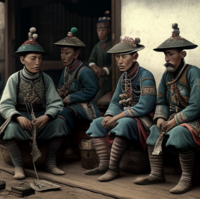Allied Mission in Greater Kildare: Difference between revisions
Continuator (talk | contribs) (Created page with "{{SANE article}} {{Infobox | title = {{PAGENAME}} | image = | label1 = Abbreviation | data1 = AMGK | label2 = Commander | data2 = The ''Imperial Decrees (Shireroth)/The Sy...") |
Continuator (talk | contribs) mNo edit summary |
||
| (9 intermediate revisions by 2 users not shown) | |||
| Line 2: | Line 2: | ||
{{Infobox | {{Infobox | ||
| title = {{PAGENAME}} | | title = {{PAGENAME}} | ||
| image = | | image = [[File:Allied Mission in Greater Kildare soldiers.png|200px]] | ||
<small>A majority of the Jingdaoese and Kildarian soldiers were demoralized at the start of 1707 AN. Years of banditry or low wages had reduced the proud army to only an empty shell by the time Jingdao was integrated into the Imperial Republic. </small> | |||
| label1 = Abbreviation | | label1 = Abbreviation | ||
| data1 = AMGK | | data1 = AMGK | ||
| Line 12: | Line 13: | ||
| data4 = Regional stabilisation mission | | data4 = Regional stabilisation mission | ||
| label5 = Status | | label5 = Status | ||
| data5 = | | data5 = Dissolved ({{AN|1727}}) | ||
| label6 = Headquarters | | label6 = Headquarters | ||
| data6 = [[Gaelen's Landing]], [[Dutchy of Kildare]] | | data6 = [[Gaelen's Landing]], [[Dutchy of Kildare]] | ||
| Line 20: | Line 21: | ||
|data8 = | |data8 = | ||
}} | }} | ||
Established in the final days of {{AN|1707}}, the '''{{PAGENAME}}''' encompassed the efforts to, firstly, reorganise the remnants of the [[Imperial Armed Forces]] into the coalition of ducal armies that would serve as auxiliaries in the [[Eastern Imperium]] for the [[Imperial Forces]] of [[Shireroth]], and also to recover the technological and industrial capacity of [[Jingdao]], originally powerfully assembled during the [[Sxiro-Jingdaoese Confrontation]], and to repurpose it so as to provide for the defence of the ducal realms during the protracted period of reintegration envisaged after the signing of the [[Treaty of Gaelen's Landing]]. | |||
Beginning as a comparatively modest operation, the Allied Mission aimed to have a liaison team, each consisting of eight officers of tribunal rank, headed by a legate, and a supporting troop of forty personnel, attached to each nascent banner group established within the operational area of [[Greater Kildare]]. The liaison teams would coordinate with the [[General Inspectorate of Apollonia Command]] and local forces, especially the heavenly banner corps being revived after the collapse of the [[Imperial Armed Forces]]. These heavenly corps, typically formed of reluctant new levies and sceptical veterans returning to the colours, would not only need to have their morale and cohesion restored but also be converted over to the [[Raspur Pact]] standards of doctrine and organisation, so as to be interoperable with the Imperial Forces, whilst accepting the authority of their new feudal overlords - the dukes appointed in the wake of the [[Treaty of Gaelen's Landing|reunification]]. | |||
The Allied Mission proved only partly successful, as from 1707 till 1716 AN, the country side remained plagued by former soldiers and veterans. Many of them had lost their job in the aftermath of the [[Second Kildarian Revolution]] and had been unable to find satisfying work in the cities. Banditry for those men became frequent, despite attempts of local lords to hire them for their own militias. A crackdown by [[Li Suyi]] during the [[Chastisement of the Hereditary Lords]] restored some semblance of order. Nonetheless, it remains advised to not travel at night and only along the larger roads. | |||
==Subordinate units== | |||
*[[Jizhi-zou]] | |||
*[[Unit 666]] | |||
{{Shireroth nav}} | |||
[[Category:Shireroth]][[Category:Greater Kildare]][[Category:Military formations of the Raspur Pact]] | |||
Latest revision as of 16:58, 13 January 2024
 A majority of the Jingdaoese and Kildarian soldiers were demoralized at the start of 1707 AN. Years of banditry or low wages had reduced the proud army to only an empty shell by the time Jingdao was integrated into the Imperial Republic.
A majority of the Jingdaoese and Kildarian soldiers were demoralized at the start of 1707 AN. Years of banditry or low wages had reduced the proud army to only an empty shell by the time Jingdao was integrated into the Imperial Republic. | |
| Abbreviation | AMGK |
|---|---|
| Commander | The Admirable & Illustrious Count of Erudition |
| Formation | 1707 AN |
| Type | Regional stabilisation mission |
| Status | Dissolved (1727 AN) |
| Headquarters | Gaelen's Landing, Dutchy of Kildare |
| Contributing Forces | |
Established in the final days of 1707 AN, the Allied Mission in Greater Kildare encompassed the efforts to, firstly, reorganise the remnants of the Imperial Armed Forces into the coalition of ducal armies that would serve as auxiliaries in the Eastern Imperium for the Imperial Forces of Shireroth, and also to recover the technological and industrial capacity of Jingdao, originally powerfully assembled during the Sxiro-Jingdaoese Confrontation, and to repurpose it so as to provide for the defence of the ducal realms during the protracted period of reintegration envisaged after the signing of the Treaty of Gaelen's Landing.
Beginning as a comparatively modest operation, the Allied Mission aimed to have a liaison team, each consisting of eight officers of tribunal rank, headed by a legate, and a supporting troop of forty personnel, attached to each nascent banner group established within the operational area of Greater Kildare. The liaison teams would coordinate with the General Inspectorate of Apollonia Command and local forces, especially the heavenly banner corps being revived after the collapse of the Imperial Armed Forces. These heavenly corps, typically formed of reluctant new levies and sceptical veterans returning to the colours, would not only need to have their morale and cohesion restored but also be converted over to the Raspur Pact standards of doctrine and organisation, so as to be interoperable with the Imperial Forces, whilst accepting the authority of their new feudal overlords - the dukes appointed in the wake of the reunification.
The Allied Mission proved only partly successful, as from 1707 till 1716 AN, the country side remained plagued by former soldiers and veterans. Many of them had lost their job in the aftermath of the Second Kildarian Revolution and had been unable to find satisfying work in the cities. Banditry for those men became frequent, despite attempts of local lords to hire them for their own militias. A crackdown by Li Suyi during the Chastisement of the Hereditary Lords restored some semblance of order. Nonetheless, it remains advised to not travel at night and only along the larger roads.
Subordinate units
| |||||||||||||||||||||||||||||||||||||
